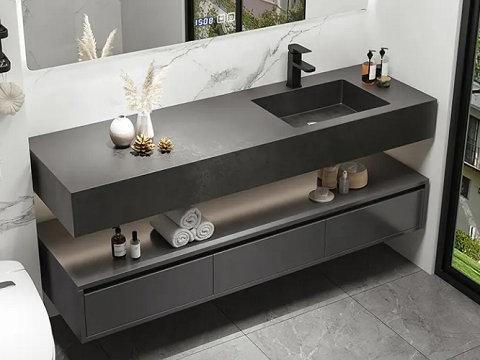Porcelain Vanity Tops
Porcelain vanity tops have carved a niche in the competitive bathroom fixtures market, cherished for their durability and aesthetic charm. In this cutthroat arena, the ability to present a rich spectrum of colors while keeping costs in check is the key to standing out. This article delves into the strategies and techniques that enable the production of porcelain bathroom countertops with diverse color palettes at budget – friendly prices.

Cost Effective Raw Material Selection
Cost effective supplier
Porcelain vanity tops rely on raw materials as the cornerstone of low – cost production. While high – quality kaolin, feldspar, and quartz are integral components, sourcing them from reliable and cost – effective suppliers can significantly trim expenses. Instead of splurging on premium – grade materials, manufacturers can opt for those that meet the basic quality benchmarks for porcelain production. For example, in regions blessed with abundant local raw material sources, forging partnerships with local suppliers can slash transportation costs.
Recycled materials
Recycled materials also play a pivotal role in cost reduction for porcelain bathroom countertops. Certain types of recycled clays and minerals can be seamlessly integrated into the porcelain mixture without compromising much of the product’s quality. This not only curbs material costs but also aligns with the burgeoning trend of sustainability, adding an extra selling point.
Innovative Coloring Techniques for Diverse Patterns
Digital printing patterns
To endow these vanity tops with a wide variety of colors without racking up excessive costs, innovative coloring techniques come into play. Digital printing is one such technique. Digital printers can effortlessly transfer intricate patterns and a vast array of colors directly onto the porcelain surface. This method allows for rapid and effortless design changes, enabling manufacturers to produce small batches of porcelain bathroom countertops with distinct color schemes, all without hefty setup costs. For instance, companies can print floral motifs, geometric patterns, or custom – designed emblems in multiple colors to cater to diverse customer tastes.
Colorants glazing process
Another cost – effective coloring approach for porcelain bathroom countertops involves the use of colorants in the glazing process. By meticulously formulating glazes with different color – adding agents, a broad spectrum of colors can be achieved. These colorants can be blended in various ratios to create unique shades and hues. Additionally, techniques like spray glazing can impart a more textured and varied appearance, enhancing the depth of the color patterns. Compared to complex and labor – intensive hand – painting techniques, this method is relatively inexpensive yet still delivers visually stunning results.
Streamlined Production Processes
Size or Colors streamlined
Porcelain vanity tops require a streamlined production process to reduce costs while maintaining the ability to offer diverse colors. Automated production lines can significantly enhance efficiency. For example, bathroom countertops in standard shapes can be rapidly produced by automated shaping machines, cutting down on the labor costs associated with manual shaping. In the drying and firing stages, advanced kiln technologies with precise temperature and humidity control ensure consistent quality while shortening production time. Faster production cycles lead to lower overhead costs and the capacity to produce more units within a specific time frame, which is beneficial for both cost – control and meeting market demand for differently colored products.
Batch production
Batch production optimization is also key for porcelain bathroom countertops. Instead of manufacturing units one by one, manufacturers can group products with similar color requirements or production processes. This minimizes the time and cost spent on changing production setups between different color and design runs. For example, all porcelain bathroom countertops with blue – based colors can be produced in one batch, followed by those with red – based colors, reducing the need for frequent adjustments in the glazing and firing processes.
Quality Control on a Budget
Porcelain vanity tops remain a priority for quality even when manufacturers aim for low-cost production. However, optimizing quality control can help keep costs in check for these countertops. Instead of conducting a 100% inspection on every single unit, manufacturers can employ statistical sampling methods for the products. By randomly selecting a specific percentage of items from each production batch for thorough inspection, potential quality issues in the countertops can be identified without the exorbitant cost of inspecting every single piece. These inspections focus on critical quality aspects of the vanity tops, such as color consistency, surface smoothness, and structural integrity. If any issues arise, corrective actions can be swiftly taken to ensure that the overall quality of each production batch meets the required standards.
Producing porcelain bathroom countertops with a diverse range of colors at a low cost is achievable through a harmonious blend of smart raw material selection, innovative coloring techniques, streamlined production processes, and efficient quality control. By implementing these strategies, manufacturers can not only satisfy the market’s appetite for aesthetically pleasing and colorful bathroom fixtures but also gain a competitive edge in terms of price, making porcelain bathroom countertops an irresistible choice for a wide array of customers.
